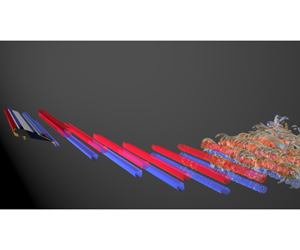Article contents
Influence of three-dimensionality on propulsive flapping
Published online by Cambridge University Press: 15 January 2020
Abstract

Propulsive flapping foils are widely studied in the development of swimming and flying animal-like autonomous systems. Numerical studies in this topic are mainly two-dimensional (2-D) studies, as they are quicker and cheaper, but this inhibits the three-dimensional (3-D) evolution of the shed vortices from leading and trailing edges. In this work, we examine the similarities and differences between 2-D and 3-D simulations through a case study in order to evaluate the efficacy and limitations of using 2-D simulations to describe a 3-D system. We simulate an infinite-span NACA0016 foil in both two and three dimensions at a Reynolds number of 5300 and an angle of attack of 10°. The foil is subject to prescribed heaving and pitching kinematics with varying trailing-edge deflection amplitude  $A$. Our primary finding is that the flow and forces are effectively 2-D at intermediate amplitude-based Strouhal numbers (
$A$. Our primary finding is that the flow and forces are effectively 2-D at intermediate amplitude-based Strouhal numbers ( $St_{A}=2Af/U$, where
$St_{A}=2Af/U$, where  $U$ is the free-stream velocity and
$U$ is the free-stream velocity and  $f$ is the flapping frequency),
$f$ is the flapping frequency),  $St_{A}\approx 0.3$ for heaving,
$St_{A}\approx 0.3$ for heaving,  $St_{A}\approx 0.3{-}0.6$ for pitching and
$St_{A}\approx 0.3{-}0.6$ for pitching and  $St_{A}\approx 0.15{-}0.45$ for coupled motion, while 3-D effects dominate outside of these ranges. These 2-D regions begin when the fluid energy induced by the flapping motion overcomes the 3-D vortex shedding found on a stationary foil, and the flow reverts back to 3-D when the strength of the shed vortices overwhelms the stabilising influence of viscous dissipation. These results indicate that 3-D to 2-D transitions or vice versa are a balance between the strength and stability of leading/trailing-edge vortices and the flapping energy. However, 2-D simulations can still be used for flapping flight/swimming studies provided that the flapping amplitude/frequency is within a given range.
$St_{A}\approx 0.15{-}0.45$ for coupled motion, while 3-D effects dominate outside of these ranges. These 2-D regions begin when the fluid energy induced by the flapping motion overcomes the 3-D vortex shedding found on a stationary foil, and the flow reverts back to 3-D when the strength of the shed vortices overwhelms the stabilising influence of viscous dissipation. These results indicate that 3-D to 2-D transitions or vice versa are a balance between the strength and stability of leading/trailing-edge vortices and the flapping energy. However, 2-D simulations can still be used for flapping flight/swimming studies provided that the flapping amplitude/frequency is within a given range.
JFM classification
- Type
- JFM Papers
- Information
- Copyright
- © The Author(s), 2020. Published by Cambridge University Press
References
Zurman-Nasution et al. supplementary movie 1
Phase-averaged vorticity-z at t=0.5/T for 3D coupled motion at AD=3.75 (StD=1.125)
Zurman-Nasution et al. supplementary movie 2
Phase-averaged vorticity-z at t=0.5/T for 2D coupled motion at AD=3.75 (StD=1.125)
- 35
- Cited by




